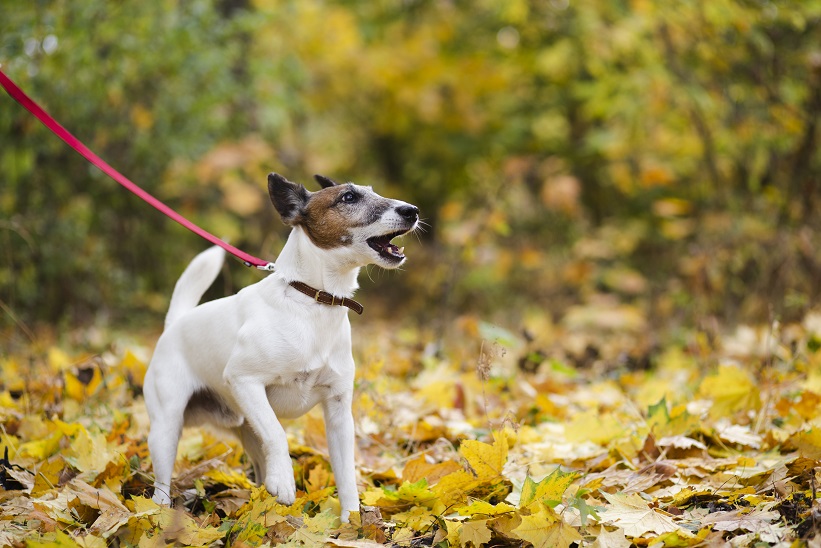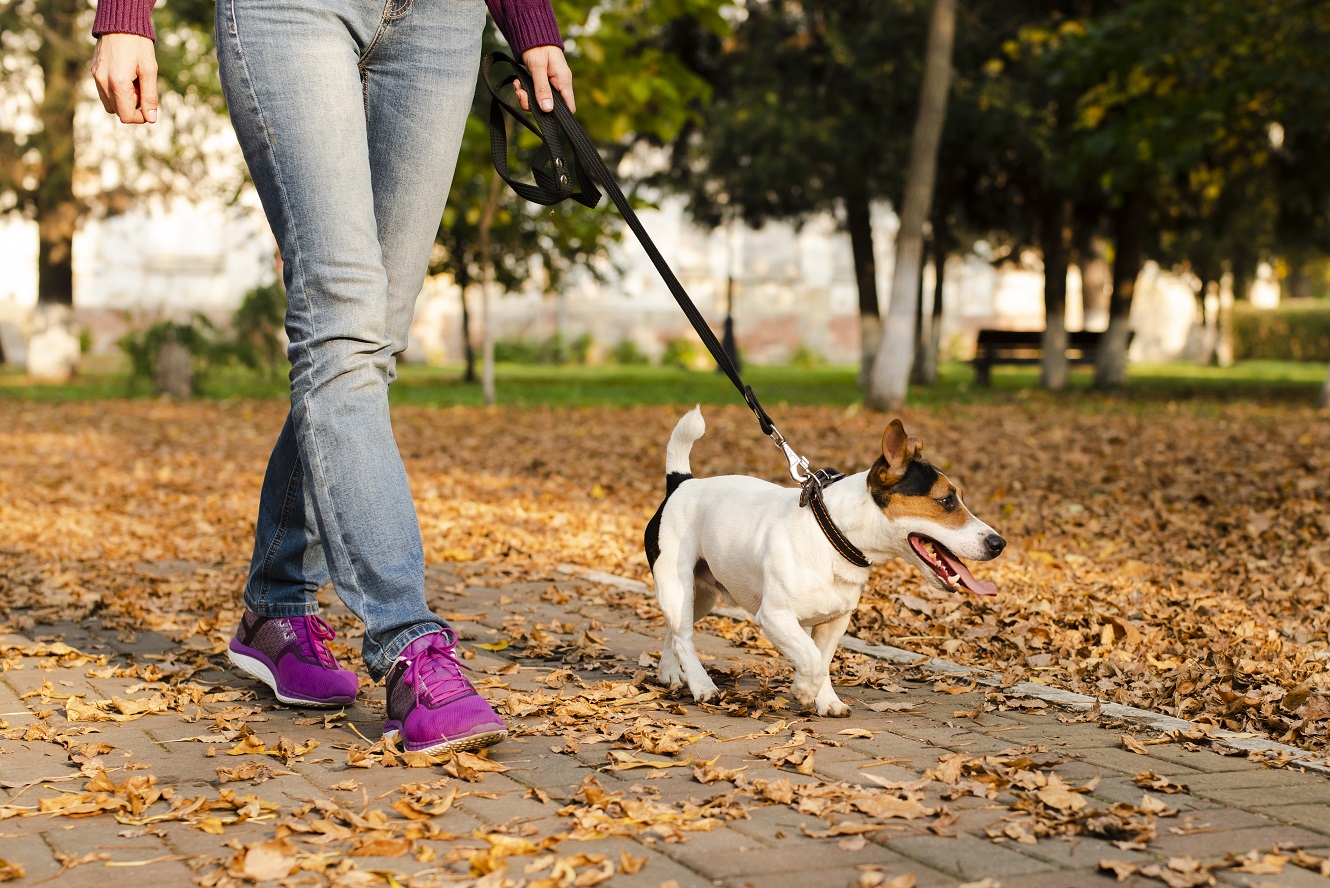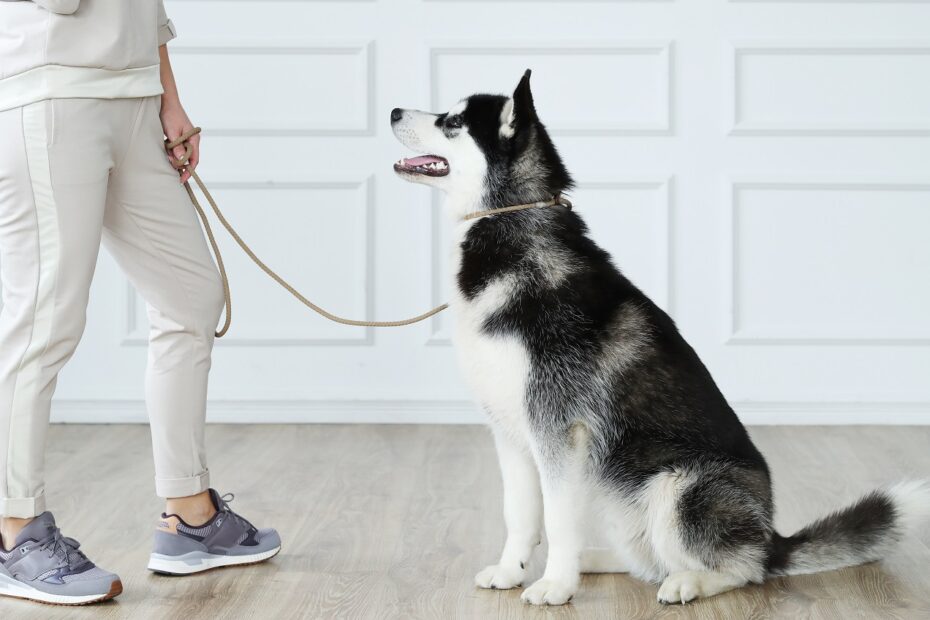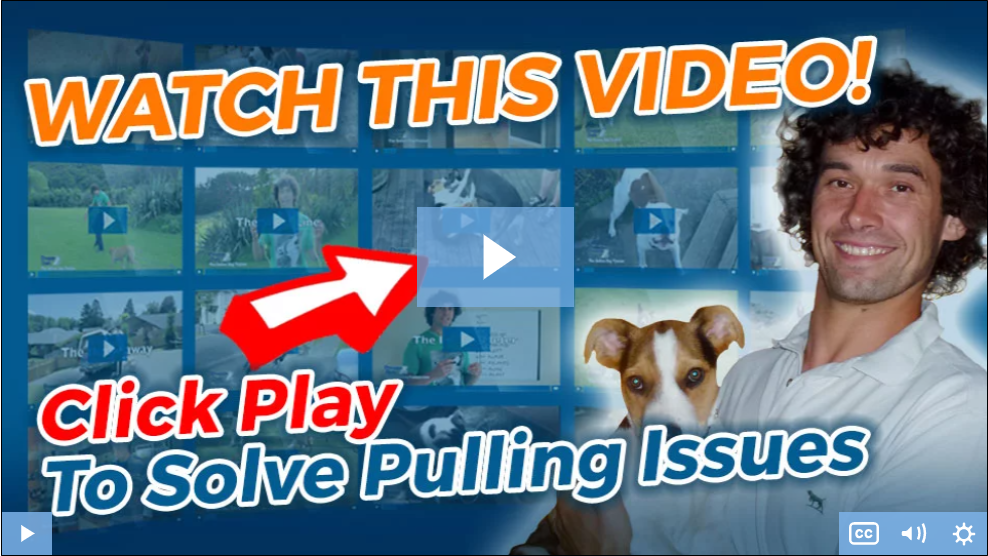If you want to learn how to train a dog to walk on a leash (without pulling), then you’re not alone.
In fact, while leash training a dog might seem like a walk in the park for some, many owners still struggle to master this skill. Which usually results in letting their dog take control of the situation.
Ultimately, this a bad idea. And allowing your dog to control the leash is the first step in letting things get out of control.
They end up pulling you in any direction that their nose takes them, and you can quite quickly find yourself in some tricky spots that certainly aren’t human-friendly!
Think about it…
How many times have you been snagged on a bush, or tangled in a tree, just because you couldn’t get your dog to stop pulling in the direction they wanted to go?
And while we’ve all looked on enviously in the park at the guy who seamlessly manages to walk six dogs at a time (all in nicely and calmly, I might add). Why is it that some of us can’t seem to set the pace when it comes to walking our own?
Now, I can’t promise that you will be able to manage six dogs on the leash at once (that’s where madness lies).
But what I can do is introduce you to some easy to impliment techniques that will help you gain better control of your canine companion without being pulled from pillar to post.
So lesson number one!
Over-excitement is one of the fundamental reasons why your dog pulls when on the leash. It’s also something that can be quickly eliminated by teaching your dog to be calm and in control of their emotions.
Better still, this is something that Dan Abdeloor (aka Doggy Dan) covers extensively over at The Online Dog Trainer. Where he introduces 5 simple calming techniques to relax your dog before heading out for a walk. (see video below)
What’s more, Dan gives you an interesting insight into many of the reasons why dogs pull on the leash, along with a PROVEN plan of action to solve many other puzzling behavior traits of your dog!
To put in bluntly, you will undoubtedly find his insight helpful if you’re hell-bent on quickly stopping your dog’s unwanted leash pulling habits.
Anyway, here’s the video link to take a look: 5 Step-By-Step Calming Exercises To Quickly Stop Your Dog Pulling The Leash…
(video will open in new window)
Why Do Dogs Pull The Leash?
Now, there are many reasons for this potentially frustrating behavior. But to better understand why your dog pulls, you need to take a minute to consider things from their point of view.
See, dogs (especially puppies or younger dogs) are full of energy, and going out for their daily walk is often one of the highlights of their day.
So in most cases, it’s only natural that they become overly excited the moment you grab the leash. And once this happens, it becomes increasingly difficult to get them to remain calm and in control.
So take note of some of the more common reasons your dog pulls the leash below.
See if any look familiar?
It’s A Learned Behavior
For other dogs, pulling on the leash is simply a learned behavior that they’ve unknowingly picked up from somewhere else.
If you often take your dog for a walk with a friend or if your pup was raised with others. They might have watched other dogs pulling their owners down the street and slowly started to develop pulling tendencies of their own.
And if this behavior wasn’t corrected, it could be the case that your dog thought it was acceptable and decided to follow suit.
The good news for you is that learned behavior can be modified. It just requires a little time and patience, along with a bulletproof plan of action.

Dogs Are Faster
Another thing that’s often overlooked is that a lot of dogs are naturally faster than us. And although it’s not our intention, we’re making them walk at a much slower pace than what they’re used to.
It’s kind of like when you see a disgruntled parent pulling their young children around the supermarket.
Because even though the child’s trying to keep up, their efforts are rendered useless against the larger stride of their adult counterparts.
Still, it’s important to try and steer them away from this unwanted behavior because, regardless of the reason, it doesn’t do you or your dog any favors in the long run.
They Think They’re In Control
Other dogs simply pull on the leash to establish control.
To them, they think it’s them who are taking you for a walk and not the other way around.
This can often be pair with pure stubbornness on your dog’s part as they attempt to get their head down and lead you astray.
Worst still, they may even ignore you completely and charge forward will little regard to any attempt you have to try and stop them.
This can be super frustrating, especially with larger breeds, as you’ll more than likely feel completely powerless to control them.
But no matter how dire the situation, it’s still something that’s manageable nonetheless.
It just takes a little pre-planning on your part.
Here’s where those 5 step-by-step calming exercises I talked about earlier can be used to their full effect.
Because if you can ultimately learn how to calm your dog and dial down their emotions before you leave the house. You’ll be in a much better position to maintain control over your dog rather than the other way around.
Over-excitement
Again, overexcitement is common in so many young dogs and is actually something they’ll probably grow out of as they mature.
That being said, nothing is guaranteed, so it’s still important that you get the situation under control sooner rather than later.
Because if not addressed swiftly, they’re likely to be charging here, there, and everywhere for the rest of their days.
And while this isn’t necessarily an issue with smaller breeds. I can tell you firsthand that a large, powerful dog pulling on the leash every day is slowly but surely going to take its toll on your shoulders.
Related Post: How To Calm An Overexcited Dog – Instant Calming Techniques

How To Train A Dog To Walk On A Leash (Without Pulling)
As we’ve just explored, your dog could be pulling on the leash for a number of reasons.
And while it could be a result of one or more of the above. It’s still something that, if left unchecked, can result in many more months (or even years) of frustration when it comes to heading out for a not so leisurely stroll.
So, what can you do to stop your dog from pulling on the leash?
Let’s dive in and look at some simple things you can do to improve your dog’s behavior for the better.
Tone Down The Excitement
While there’s nothing better than an excitable dog greeting you when you wake up or get home from work. Too much is enough to drive anyone crazy. Which in turn and can lead to a whole host of challenging behaviors.
You need to understand that dogs have a lot of natural energy anyway. And the more excited they get, the more they need an outlet to use it up!
With this in mind, daily walks are often one of the best ways to reduce this pent-up energy.
The problem, however, is that it is this same energy that sends your dog into full-blown crazy mode before you’ve even headed out.
So if, like most, your dog gets overly excited just before you head out for a walk, try the following to see how it affects your dogs’ natural instinct to pull.
Step #1: Schedule playtime before you go out for a walk.
You might find that if you spend time playing with your pup in the house or garden before you go out for a walk. You’ll naturally drain some of their initial energy and excitement, making them easier to control when you’re out.
Step #2: Make it less obvious you’re going out for a walk.
Dogs are very intelligent and know when it’s time for both food and exercise.
As a result, they will immediately get excited in the build-up to their walk.
To combat this, you could try keeping the leash and collar in a different location or taking your dog out of the front door instead of the side gate.
Better still, you could even leave the leash on your dog for 10-15 minutes before stepping out the door.
The options here are endless if you’re willing to think outside the box. But by disrupting the pattern, you can sometimes control how excited they get before setting off.
Change Direction
A previously discussed, some dogs instinctively think they’re the ones taking their owners for a walk and not the other way around.
When this happens, your dog ultimately ends up dictating the pace while dragging their owners along for the ride.
As a result, they generally tend to just ignore orders and just going wherever they please!
To put it bluntly, if your dog thinks they’re in charge, there’s no way they are going to be inclined to follow instructions as and when you give them.
A simple and effective way to take back control of the leash is to continually change direction while you’re walking.
It might look a little crazy to onlookers while you’re out and about in the park, but it’s actually a really effective way to get your dog to follow you.
You could even take it one step further by applying the same technique in your own front yard.
To apply it, simply take your dog out into the front yard as you normally would before heading out for a walk.
But just as you start to feel the leash tighten and that all too familiar pull, stop, change direction, and start heading back towards the house.
It might take several attempts before your dog starts to get the message. But as long as you’re consistent, your dog will eventually get the idea that pulling equals no walk!
For clarification, you can see this in action from Dan Abdelnoor in the video below…
Use A Chest-Led Harness
Chest-led harnesses are often referred to as ‘no-pull harnesses,” thanks to their ability to stop dogs from pulling forward while walking.
They have straps that cross above your dog’s shoulders and can be fastened at the center of your dog’s chest.
The way they’re designed means that your dog has to stay by your side if they want to keep moving forward.
And if they do pull, the leash goes to the side rather than back, which then redirects your dog right back to you.
They’re actually incredibly effective at stopping your dog from pulling, and they have the added benefit of protecting your dog’s neck.
Use The Stop & Start Method
This kind of works similar to the change direction method we discussed earlier. But I thought I’d include it because it’s another great exercise to impliment to teach your dog that pulling isn’t to be tolerated.
So the way this works is that whenever you start to feel the relentless pull of the leash…
…Stop walking
…Wait for your dog to relax
…Repeat as needed
And that’s it!
Although this can be time-consuming, it’s a proven way of getting your dog to understand that pulling the leash means the end of the fun.
You need to be consistent here aswell because if you only apply the exercises sometimes and then follow your dog’s lead the rest, they won’t understand that they’re doing anything wrong.
However, if you make a point of stopping every time they lead you astray, they’ll quickly realize that pulling is a no-go.
In time, you should start to notice that your dog is less inclined to venture off on their own while dragging you along for the ride.
Related Post: 4 Simple Steps To Leash Training An Older Dog

Wrapping Things Up
While leash pulling can but a pain in the proverbial at times, it’s also a very manageable behavior given enough time, patience, and guidance.
Just remember that nothing happens overnight, and you’re likely to suffer a few hiccups and setbacks along the way.
But by following the above advice aswell as the 5 step-by-step calming exercises, you can ultimately get leash pulling under control sooner rather than later.

